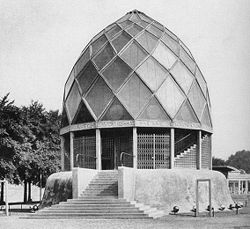.gif)
Werkbund Exhibition (1914)
Encyclopedia

Deutscher Werkbund
The Deutscher Werkbund was a German association of artists, architects, designers, and industrialists. The Werkbund was to become an important event in the development of modern architecture and industrial design, particularly in the later creation of the Bauhaus school of design...
Exhibition of 1914 was held at Rheinpark
Rheinpark
The Rheinpark is a 40 hectare large urban park along the right bank of the River Rhine in Cologne, Germany. The park lies between the Cologne districts of Deutz and Mülheim and includes a beach club, an open air theater and a Roman Thermae styled public bath...
in Cologne
Cologne
Cologne is Germany's fourth-largest city , and is the largest city both in the Germany Federal State of North Rhine-Westphalia and within the Rhine-Ruhr Metropolitan Area, one of the major European metropolitan areas with more than ten million inhabitants.Cologne is located on both sides of the...
, Germany. Bruno Taut
Bruno Taut
Bruno Julius Florian Taut , was a prolific German architect, urban planner and author active during the Weimar period....
's best-known building, the prismatic dome of the Glass Pavilion
Glass Pavilion
The Glass Pavilion, built in 1914 and designed by Bruno Taut, was a prismatic glass dome structure at the Cologne Deutscher Werkbund Exhibition. The structure was a brightly colored landmark of the exhibition, and was constructed using concrete and glass. The concrete structure had inlaid colored...
of which only black and white images survive today, was in reality a brightly colored landmark. Walter Gropius
Walter Gropius
Walter Adolph Georg Gropius was a German architect and founder of the Bauhaus School who, along with Ludwig Mies van der Rohe and Le Corbusier, is widely regarded as one of the pioneering masters of modern architecture....
and Adolf Meyer
Adolf Meyer (architect)
Adolf Meyer was a German architect. A student and employee of Peter Behrens, Meyer became the office boss of the firm of Walter Gropius around 1915 and a full partner afterwards. In 1919 Gropius appointed Meyer as a master at the Bauhaus, where he taught work drawing and construction technique...
designed a model factory for the exhibition. The Belgian architect Henri van de Velde
Henry van de Velde
Henry Clemens Van de Velde was a Belgian Flemish painter, architect and interior designer. Together with Victor Horta and Paul Hankar he could be considered one of the main founders and representatives of Art Nouveau in Belgium...
designed a model theatre.
The exhibition happened mainly on the initiative of the later German chancellor Konrad Adenauer
Konrad Adenauer
Konrad Hermann Joseph Adenauer was a German statesman. He was the chancellor of the West Germany from 1949 to 1963. He is widely recognised as a person who led his country from the ruins of World War II to a powerful and prosperous nation that had forged close relations with old enemies France,...
, then a 36 years old aspiring inventor, Werkbund member and local politician at Cologne. The city spent the luxurious sum of 5 million Goldmark
German gold mark
The Goldmark was the currency used in the German Empire from 1873 to 1914.-History:Before unification, the different German states issued a variety of different currencies, though most were linked to the Vereinsthaler, a silver coin containing 16⅔ grams of pure silver...
s on the event. Planning begain in earnest in 1912, and construction work started in early 1914. The exhibition was opened to the public by Van de Velde on May 15th, 1914. Scheduled to last until the end of October, it was prematurely shut down on August 8th, in reaction to the outbreak of World War I
World War I
World War I , which was predominantly called the World War or the Great War from its occurrence until 1939, and the First World War or World War I thereafter, was a major war centred in Europe that began on 28 July 1914 and lasted until 11 November 1918...
a week earlier; the exhibition buildings were dismantled shortly afterwards.
There were two more Werkbund
Deutscher Werkbund
The Deutscher Werkbund was a German association of artists, architects, designers, and industrialists. The Werkbund was to become an important event in the development of modern architecture and industrial design, particularly in the later creation of the Bauhaus school of design...
Exhibitions after the war. The second was the Stuttgart Exhibition of 1927, which included the Weissenhof Estate
Weissenhof Estate
The Weissenhof Estate is a housing estate built for exhibition in Stuttgart in 1927...
. At that time, the third Werkbund Exhibition had been tentatively scheduled for 1937, but the plan was shelved in 1932 because of the Great Depression
Great Depression
The Great Depression was a severe worldwide economic depression in the decade preceding World War II. The timing of the Great Depression varied across nations, but in most countries it started in about 1929 and lasted until the late 1930s or early 1940s...
and could not be taken up again since the Nazis opposed and ultimately outlawed the Werkbund. It finally took place on a reduced scale in 1949, back in Cologne, and turned out to be the last Werkbund Exhibition.

